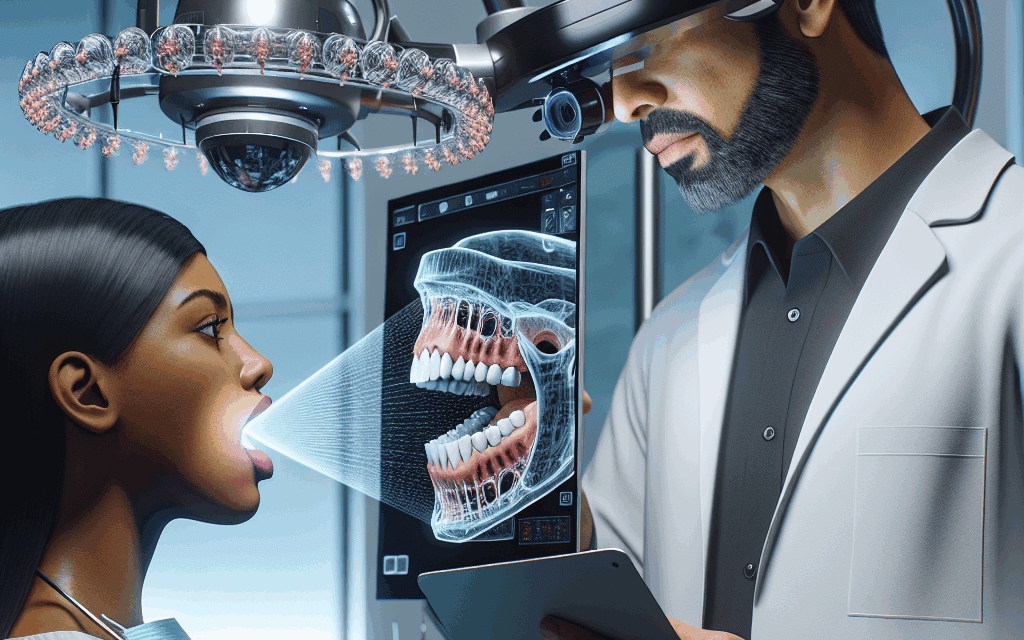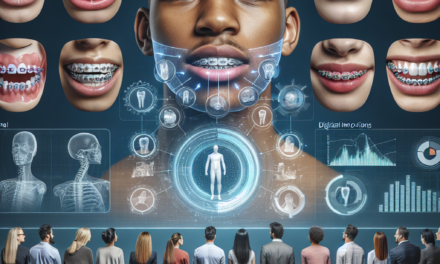Revolutionizing Orthodontics Through Cutting-Edge Imaging Solutions
Orthodontics has undergone a significant transformation over the past few decades, driven by advancements in technology and imaging solutions. The integration of cutting-edge imaging techniques has not only improved diagnostic accuracy but has also enhanced treatment planning and patient outcomes. This article explores the various ways in which innovative imaging solutions are revolutionizing orthodontics, focusing on five key areas: 3D Imaging Technologies, Digital Workflow Integration, Enhanced Treatment Planning, Patient Communication and Engagement, and Future Trends in Orthodontic Imaging.
3D Imaging Technologies
Three-dimensional imaging technologies have emerged as a cornerstone of modern orthodontics. Traditional 2D X-rays provided limited information, often leading to misdiagnosis or incomplete treatment plans. In contrast, 3D imaging technologies, such as Cone Beam Computed Tomography (CBCT) and intraoral scanning, offer comprehensive views of the dental and skeletal structures.
Understanding Cone Beam Computed Tomography (CBCT)
CBCT is a revolutionary imaging technique that captures high-resolution 3D images of the craniofacial region. Unlike conventional X-rays, which provide flat images, CBCT allows orthodontists to visualize the spatial relationships between teeth, bones, and soft tissues. This capability is crucial for accurate diagnosis and treatment planning.
- Improved Diagnosis: CBCT provides detailed images that help orthodontists identify issues such as impacted teeth, root resorption, and skeletal discrepancies.
- Enhanced Treatment Planning: With 3D visualization, orthodontists can create more precise treatment plans tailored to the individual needs of each patient.
- Reduced Radiation Exposure: CBCT typically exposes patients to lower radiation levels compared to traditional medical CT scans, making it a safer option for imaging.
Research has shown that the use of CBCT in orthodontics can lead to better treatment outcomes. A study published in the American Journal of Orthodontics and Dentofacial Orthopedics found that orthodontists who utilized CBCT were able to achieve more accurate diagnoses and treatment plans, resulting in shorter treatment times and improved patient satisfaction.
Intraoral Scanning: A Game Changer
Intraoral scanners have revolutionized the way orthodontists capture dental impressions. Traditional impressions often caused discomfort and were prone to inaccuracies. In contrast, intraoral scanners provide a digital alternative that is both comfortable and precise.
- Comfort and Convenience: Patients appreciate the comfort of digital impressions, which eliminate the need for messy materials and gag-inducing trays.
- Real-Time Feedback: Orthodontists can view the digital impressions in real-time, allowing for immediate adjustments and corrections.
- Seamless Integration: Digital impressions can be easily integrated into treatment planning software, streamlining the workflow.
Case studies have demonstrated that practices utilizing intraoral scanning report higher patient satisfaction rates and improved treatment accuracy. For instance, a dental practice in California reported a 30% increase in patient referrals after implementing intraoral scanning technology.
Digital Workflow Integration
The integration of digital workflows in orthodontics has streamlined processes, reduced errors, and improved overall efficiency. By combining imaging solutions with digital tools, orthodontists can enhance their practice’s productivity and patient care.
From Imaging to Treatment Planning
Digital workflows allow orthodontists to transition seamlessly from imaging to treatment planning. Once 3D images are captured, they can be imported into specialized software that aids in treatment simulation and planning.
- Virtual Treatment Planning: Orthodontists can simulate various treatment options and visualize the expected outcomes before initiating any procedures.
- Collaboration with Laboratories: Digital files can be easily shared with dental laboratories for the fabrication of custom appliances, reducing turnaround times.
- Enhanced Accuracy: Digital workflows minimize human error associated with manual processes, leading to more precise treatment outcomes.
A notable example of digital workflow integration is the use of software like Invisalign’s ClinCheck, which allows orthodontists to create a virtual treatment plan that patients can visualize. This not only enhances the treatment experience but also fosters trust and transparency between the orthodontist and the patient.
Streamlining Administrative Processes
In addition to clinical applications, digital workflows also streamline administrative processes within orthodontic practices. Scheduling, billing, and patient communication can all be managed through integrated software solutions.
- Automated Appointment Reminders: Digital systems can send automated reminders to patients, reducing no-show rates and improving practice efficiency.
- Centralized Patient Records: Digital records allow for easy access to patient information, treatment history, and imaging files, facilitating better care coordination.
- Data Analytics: Practices can leverage data analytics to track performance metrics, patient satisfaction, and treatment outcomes, enabling continuous improvement.
Research indicates that practices adopting digital workflows experience increased operational efficiency and improved patient retention rates. A survey conducted by the American Association of Orthodontists found that practices utilizing digital solutions reported a 25% increase in patient satisfaction.
Enhanced Treatment Planning
Cutting-edge imaging solutions have significantly enhanced treatment planning in orthodontics. With advanced imaging technologies, orthodontists can create more accurate and personalized treatment plans that cater to the unique needs of each patient.
Precision in Treatment Planning
Advanced imaging techniques allow orthodontists to analyze the dental and skeletal structures in great detail. This precision enables them to develop treatment plans that are not only effective but also efficient.
- Customized Treatment Options: Orthodontists can design treatment plans that consider the specific anatomical features of each patient, leading to better outcomes.
- Predictable Results: With the ability to visualize treatment outcomes through simulation, orthodontists can provide patients with realistic expectations.
- Reduced Treatment Times: Accurate treatment planning can lead to shorter treatment durations, minimizing the time patients spend in braces or aligners.
A case study involving a group of orthodontists using advanced imaging technologies demonstrated a 20% reduction in treatment times compared to traditional methods. This not only improved patient satisfaction but also allowed orthodontists to take on more cases, increasing practice revenue.
Orthodontic Appliances and Customization
The integration of imaging solutions has also facilitated the development of custom orthodontic appliances. With precise imaging data, orthodontists can create appliances that fit perfectly and address specific dental issues.
- 3D Printed Appliances: The use of 3D printing technology allows for the rapid production of custom appliances, reducing wait times for patients.
- Aligners and Retainers: Custom aligners and retainers can be designed based on individual treatment plans, ensuring optimal fit and effectiveness.
- Enhanced Comfort: Custom appliances are often more comfortable for patients, leading to better compliance and treatment outcomes.
For example, a study published in the Journal of Orthodontics found that patients using custom 3D-printed aligners reported higher comfort levels and satisfaction compared to those using standard aligners. This highlights the importance of personalized treatment in achieving successful outcomes.
Patient Communication and Engagement
Effective communication is essential in orthodontics, as it fosters trust and collaboration between orthodontists and patients. Cutting-edge imaging solutions have transformed how orthodontists communicate treatment plans and progress to their patients.
Visualizing Treatment Plans
One of the most significant advantages of advanced imaging technologies is the ability to visualize treatment plans. Orthodontists can present 3D images and simulations to patients, helping them understand their treatment journey.
- Enhanced Understanding: Visual aids help patients grasp complex concepts related to their dental health and treatment options.
- Informed Decision-Making: Patients are more likely to engage in their treatment when they can visualize the expected outcomes and understand the rationale behind the proposed plan.
- Building Trust: Transparency in treatment planning fosters trust between orthodontists and patients, leading to better compliance and satisfaction.
A survey conducted by the American Association of Orthodontists found that 85% of patients felt more confident in their treatment decisions when presented with visual aids. This underscores the importance of effective communication in orthodontic practice.
Engaging Patients Through Technology
In addition to visualizing treatment plans, orthodontists can leverage technology to engage patients throughout their treatment journey. Mobile apps and online portals allow patients to track their progress, schedule appointments, and communicate with their orthodontist.
- Progress Tracking: Patients can monitor their treatment progress through visual updates, which can motivate them to adhere to their treatment plans.
- Direct Communication: Online platforms enable patients to ask questions and receive timely responses from their orthodontist, enhancing the patient experience.
- Educational Resources: Digital platforms can provide patients with educational materials about their treatment, empowering them to take an active role in their oral health.
For instance, a dental practice in New York implemented a mobile app that allowed patients to track their aligner changes and receive reminders for appointments. The practice reported a 40% increase in patient engagement and satisfaction after introducing this technology.
Future Trends in Orthodontic Imaging
The field of orthodontics is continuously evolving, and several emerging trends in imaging solutions are poised to shape the future of the profession. As technology advances, orthodontists will have access to even more sophisticated tools that enhance diagnosis, treatment planning, and patient care.
Artificial Intelligence in Imaging
Artificial intelligence (AI) is making its way into orthodontic imaging, offering the potential for enhanced diagnostic capabilities. AI algorithms can analyze imaging data to identify patterns and anomalies that may be missed by the human eye.
- Automated Diagnosis: AI can assist orthodontists in diagnosing conditions such as malocclusion or skeletal discrepancies more accurately and efficiently.
- Predictive Analytics: AI can analyze historical data to predict treatment outcomes, helping orthodontists make informed decisions about treatment plans.
- Continuous Learning: AI systems can learn from new data, improving their diagnostic accuracy over time.
A pilot study conducted by a leading orthodontic research institution demonstrated that AI-assisted imaging analysis improved diagnostic accuracy by 15% compared to traditional methods. This highlights the potential of AI to revolutionize orthodontic practice.
Integration of Virtual Reality (VR) and Augmented Reality (AR)
Virtual reality and augmented reality technologies are also making their way into orthodontics. These immersive technologies can enhance patient education and engagement by providing interactive experiences.
- Virtual Treatment Simulations: Patients can experience a virtual simulation of their treatment journey, helping them visualize the process and outcomes.
- AR for Patient Education: Augmented reality applications can overlay digital information onto real-world images, providing patients with a deeper understanding of their dental health.
- Enhanced Training for Orthodontists: VR can be used for training purposes, allowing orthodontists to practice procedures in a simulated environment.
A dental school in Texas recently implemented VR training for its orthodontic residents, resulting in improved procedural skills and confidence among students. This innovative approach to training is expected to become more widespread in the coming years.
Conclusion
The integration of cutting-edge imaging solutions in orthodontics has revolutionized the field, enhancing diagnostic accuracy, treatment planning, and patient engagement. Technologies such as CBCT, intraoral scanning, and digital workflows have streamlined processes and improved patient outcomes. As we look to the future, advancements in artificial intelligence, virtual reality, and augmented reality promise to further transform orthodontic practice.
Orthodontists who embrace these innovations will not only improve their clinical efficiency but also enhance the overall patient experience. By leveraging advanced imaging solutions, orthodontists can provide personalized care that meets the unique needs of each patient, ultimately leading to better treatment outcomes and higher patient satisfaction.
In summary, the revolution in orthodontics through cutting-edge imaging solutions is not just a trend; it is a fundamental shift that is reshaping the way orthodontic care is delivered. As technology continues to evolve, orthodontists must stay informed and adapt to these changes to remain at the forefront of the profession.





